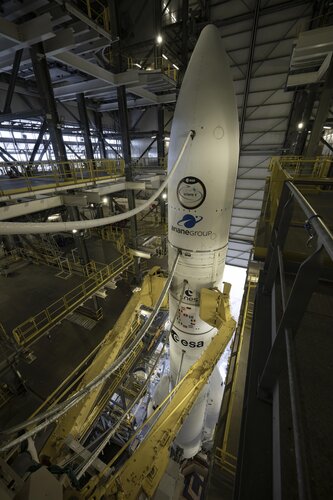The first Ariane 6 that will be launched into space seen inside its mobile building at Europe's Spaceport in French Guiana, 8 July 2024, the day before launch.
The final assembly for Europe's new rocket Ariane 6 is done inside a colossal 90-m tall mobile gantry building.
Hours before liftoff the mobile building rolls 120 m away from the launch pad, allowing Ariane 6 to stand free and be ready for loading of propellant and then liftoff for its first flight designated VA262.
Pumping fuel into an Ariane 6 rocket takes about 3,5 hours, as technicians at the control centre first began by slowly cooling the pipes, valves, tanks and engines from the tropical temperatures in French Guiana of about 30°C down to the super-chilled temperatures of the cryogenic fuels.
As much an art as engineering, the propellants used by Europe’s new rocket Ariane 6 are supercooled to –180°C for the oxygen and –253°C for the hydrogen fuel. At these temperatures, any humidity already in the pipes would immediately freeze and could lead to blocked valves. To avoid this, any hint of air or moisture from the atmosphere is flushed out of the system by the unreactive gas, helium, before fuelling begins.
This Ariane 6 has two boosters set to propel a varied selection of experiments, satellites, payload deployers and reentry demonstrations that represent thousands across Europe, from students to industry and experienced space actors NASA and ArianeGroup.
Ariane 6 is Europe’s newest heavy-lift rocket, designed to provide great power and flexibility at a lower cost than its predecessors. The launcher’s configuration – with an upgraded main stage, a choice of either two or four powerful boosters and a new restartable upper stage – will provide Europe with greater efficiency and possibility as it can launch multiple missions into different orbits on a single flight, while its upper stage will deorbit itself at the end of mission.



 Image:
Ariane 6 the day before launch
Image:
Ariane 6 the day before launch